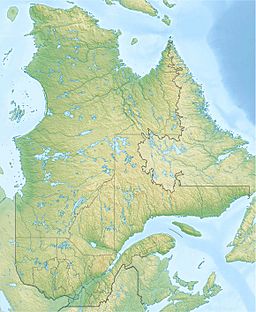Lac Sakami facts for kids
Quick facts for kids Lac Sakami |
|
|---|---|
| Location | Nord-du-Québec, Quebec |
| Coordinates | 53°15′07″N 76°45′41″W / 53.25194°N 76.76139°W |
| Primary outflows | Sakami River, Eastmain River |
| Basin countries | Canada |
| Surface area | 738 km2 (285 sq mi) |
| Average depth | 113 m (371 ft) |
| Surface elevation | 186 m (610 ft) |
Lac Sakami is a very large lake in the northwest part of Quebec, Canada. It is special because it also works as a huge water storage area, known as a reservoir. This reservoir helps create electricity for many homes and businesses.
Contents
Lac Sakami: A Key Part of Quebec's Water System
Lac Sakami is located east of James Bay. You can find it south of the Robert-Bourassa Reservoir and north of the Opinaca Reservoir. It is a significant natural feature in the Nord-du-Québec region.
This lake is quite large. It covers an area of about 738 square kilometers (285 square miles). That's bigger than many cities! Its deepest point goes down about 113 meters (371 feet). The lake sits at an elevation of 186 meters (610 feet) above sea level.
Long ago, the Cree people lived near this lake. They called it Mesackamee. This name means "big lake" or "large body of water," which perfectly describes it.
What is a Reservoir?
A reservoir is like a giant, human-made lake. It is built to store a lot of water. People create reservoirs for many reasons. They can provide drinking water, help control floods, or generate electricity.
To make a reservoir, engineers often build a dam across a river. This dam holds back the water, causing it to fill up a valley or a natural lake basin. The water level in a reservoir can be controlled. This means it can be released when needed.
The James Bay Project and Lac Sakami
Lac Sakami is now an important part of the James Bay Project. This is a huge hydroelectric project in Quebec. Hydroelectric means generating electricity using the power of moving water. The project started in the 1970s. Its goal was to use the vast water resources of the James Bay region to produce clean energy.
The James Bay Project involved building many dams and power plants. It also changed the flow of several rivers and created new reservoirs. These changes helped to make a lot of electricity for Quebec.
How Lac Sakami Changed
Before the James Bay Project, Lac Sakami was a natural lake. It had an area of about 533 square kilometers (206 square miles). When it became part of the project, its size grew. Water from other rivers was redirected into it. This made Lac Sakami much larger and deeper.
Today, Lac Sakami acts as a large storage basin. It holds water that can be released into other parts of the James Bay hydroelectric system. This controlled release of water helps to power the turbines in the generating stations. These turbines then create electricity.
The transformation of Lac Sakami shows how humans can change natural landscapes. This is done to meet energy needs. It also highlights the importance of water as a resource.


